Coventry University Consultancy Report: TATA Group Strategic Analysis
VerifiedAdded on 2023/04/23
|18
|4495
|278
Report
AI Summary
This report provides a strategic analysis of the TATA Group, a renowned Indian conglomerate operating in diverse sectors. The analysis begins with an introduction to the company, its history, and global presence. Section 1 focuses on a strategic position analysis, utilizing SWOT and PEST frameworks to evaluate internal and external factors. It examines leadership, communication, company culture, ethics, sector position, and client needs. The main issue identified is the need for improved training and alignment of business aspects with strategic goals. Section 2 presents recommendations, including alternating managers across sectors, fostering collaboration, and refining communication. Section 3 discusses the implementation of these recommendations, analyzing leadership styles and stakeholder communication. Section 4 offers a critical reflection on the analysis techniques. The report concludes with a summary of findings and recommendations, providing insights into the TATA Group's strategic landscape and areas for development.
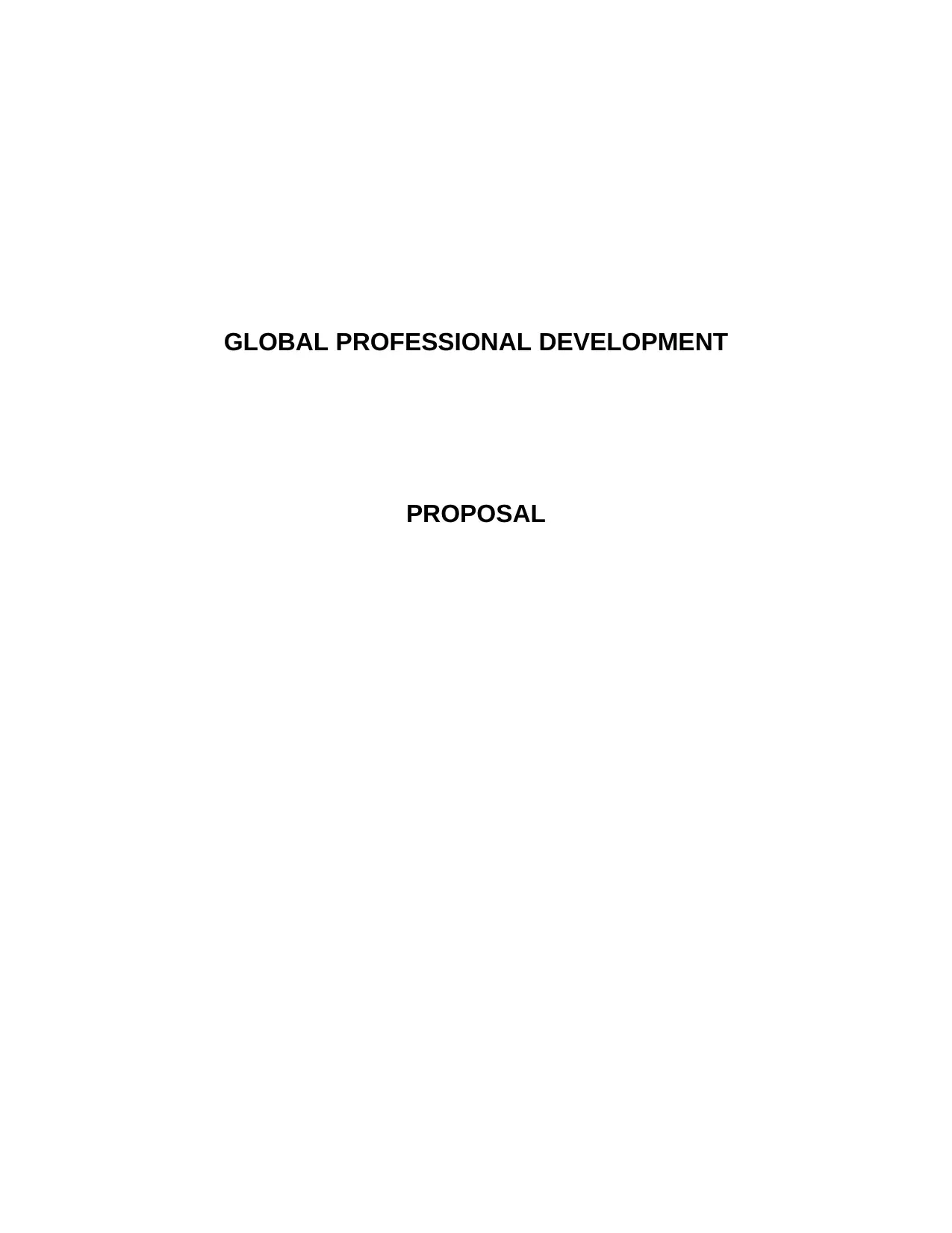
GLOBAL PROFESSIONAL DEVELOPMENT
PROPOSAL
PROPOSAL
Paraphrase This Document
Need a fresh take? Get an instant paraphrase of this document with our AI Paraphraser
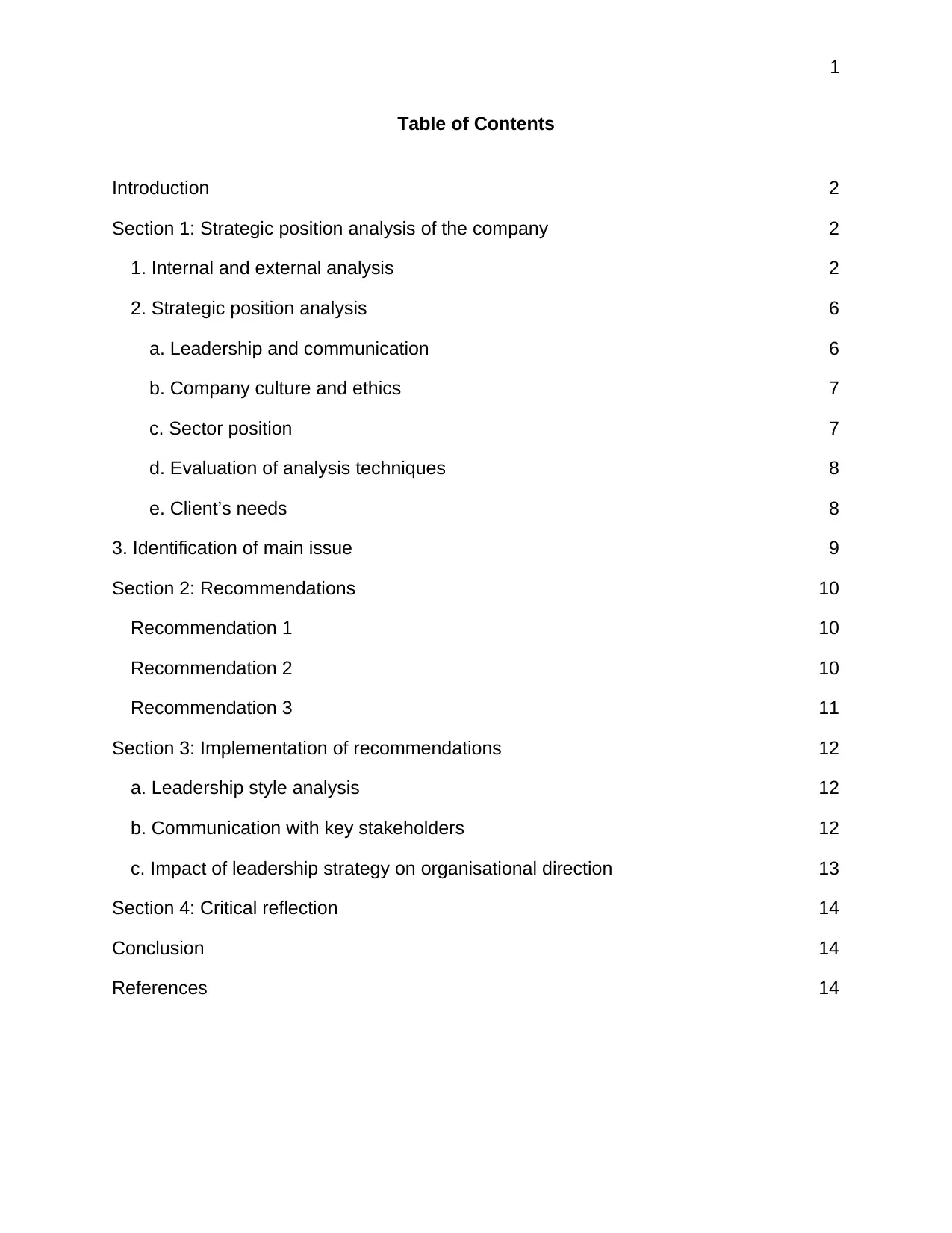
1
Table of Contents
Introduction 2
Section 1: Strategic position analysis of the company 2
1. Internal and external analysis 2
2. Strategic position analysis 6
a. Leadership and communication 6
b. Company culture and ethics 7
c. Sector position 7
d. Evaluation of analysis techniques 8
e. Client’s needs 8
3. Identification of main issue 9
Section 2: Recommendations 10
Recommendation 1 10
Recommendation 2 10
Recommendation 3 11
Section 3: Implementation of recommendations 12
a. Leadership style analysis 12
b. Communication with key stakeholders 12
c. Impact of leadership strategy on organisational direction 13
Section 4: Critical reflection 14
Conclusion 14
References 14
Table of Contents
Introduction 2
Section 1: Strategic position analysis of the company 2
1. Internal and external analysis 2
2. Strategic position analysis 6
a. Leadership and communication 6
b. Company culture and ethics 7
c. Sector position 7
d. Evaluation of analysis techniques 8
e. Client’s needs 8
3. Identification of main issue 9
Section 2: Recommendations 10
Recommendation 1 10
Recommendation 2 10
Recommendation 3 11
Section 3: Implementation of recommendations 12
a. Leadership style analysis 12
b. Communication with key stakeholders 12
c. Impact of leadership strategy on organisational direction 13
Section 4: Critical reflection 14
Conclusion 14
References 14
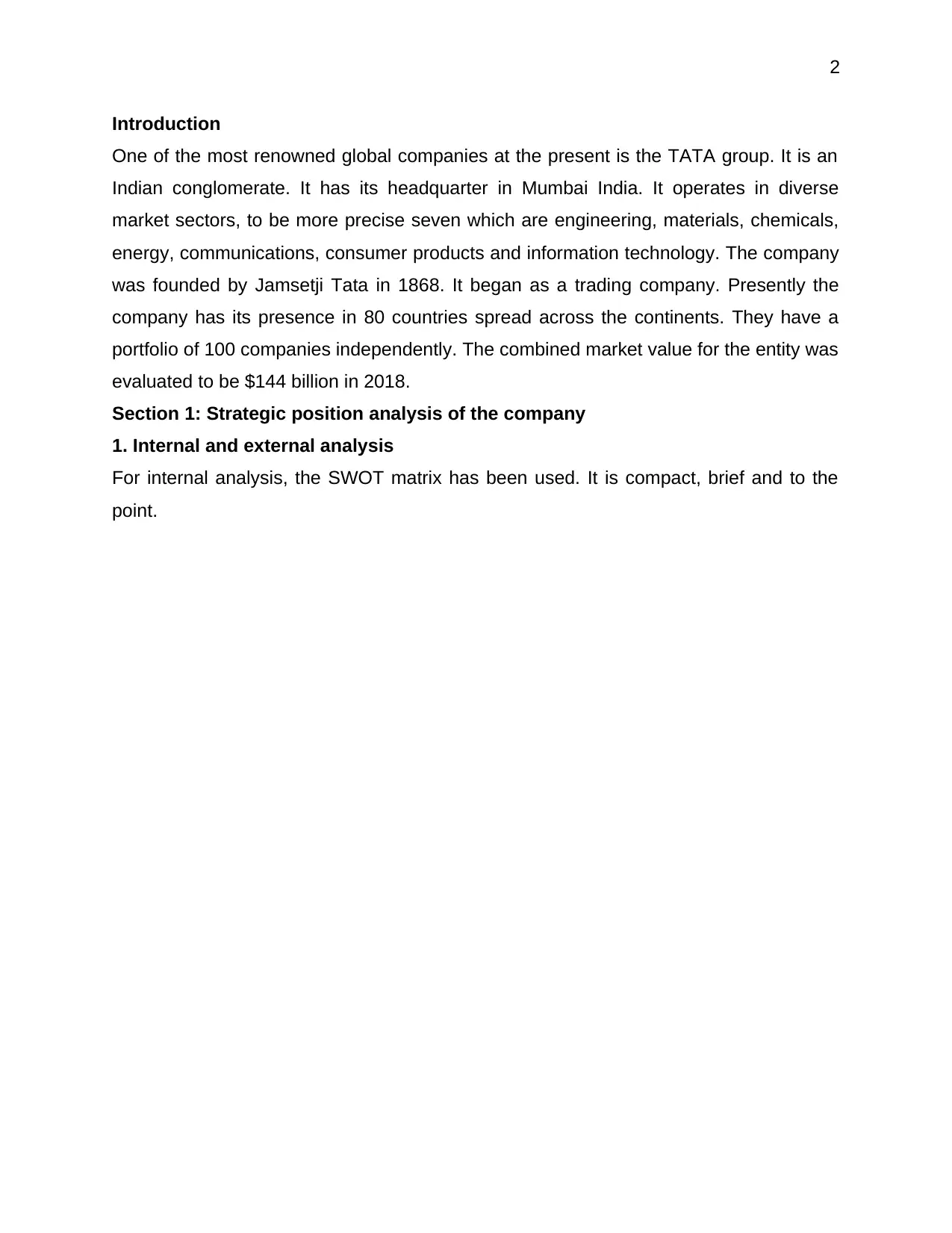
2
Introduction
One of the most renowned global companies at the present is the TATA group. It is an
Indian conglomerate. It has its headquarter in Mumbai India. It operates in diverse
market sectors, to be more precise seven which are engineering, materials, chemicals,
energy, communications, consumer products and information technology. The company
was founded by Jamsetji Tata in 1868. It began as a trading company. Presently the
company has its presence in 80 countries spread across the continents. They have a
portfolio of 100 companies independently. The combined market value for the entity was
evaluated to be $144 billion in 2018.
Section 1: Strategic position analysis of the company
1. Internal and external analysis
For internal analysis, the SWOT matrix has been used. It is compact, brief and to the
point.
Introduction
One of the most renowned global companies at the present is the TATA group. It is an
Indian conglomerate. It has its headquarter in Mumbai India. It operates in diverse
market sectors, to be more precise seven which are engineering, materials, chemicals,
energy, communications, consumer products and information technology. The company
was founded by Jamsetji Tata in 1868. It began as a trading company. Presently the
company has its presence in 80 countries spread across the continents. They have a
portfolio of 100 companies independently. The combined market value for the entity was
evaluated to be $144 billion in 2018.
Section 1: Strategic position analysis of the company
1. Internal and external analysis
For internal analysis, the SWOT matrix has been used. It is compact, brief and to the
point.
⊘ This is a preview!⊘
Do you want full access?
Subscribe today to unlock all pages.

Trusted by 1+ million students worldwide
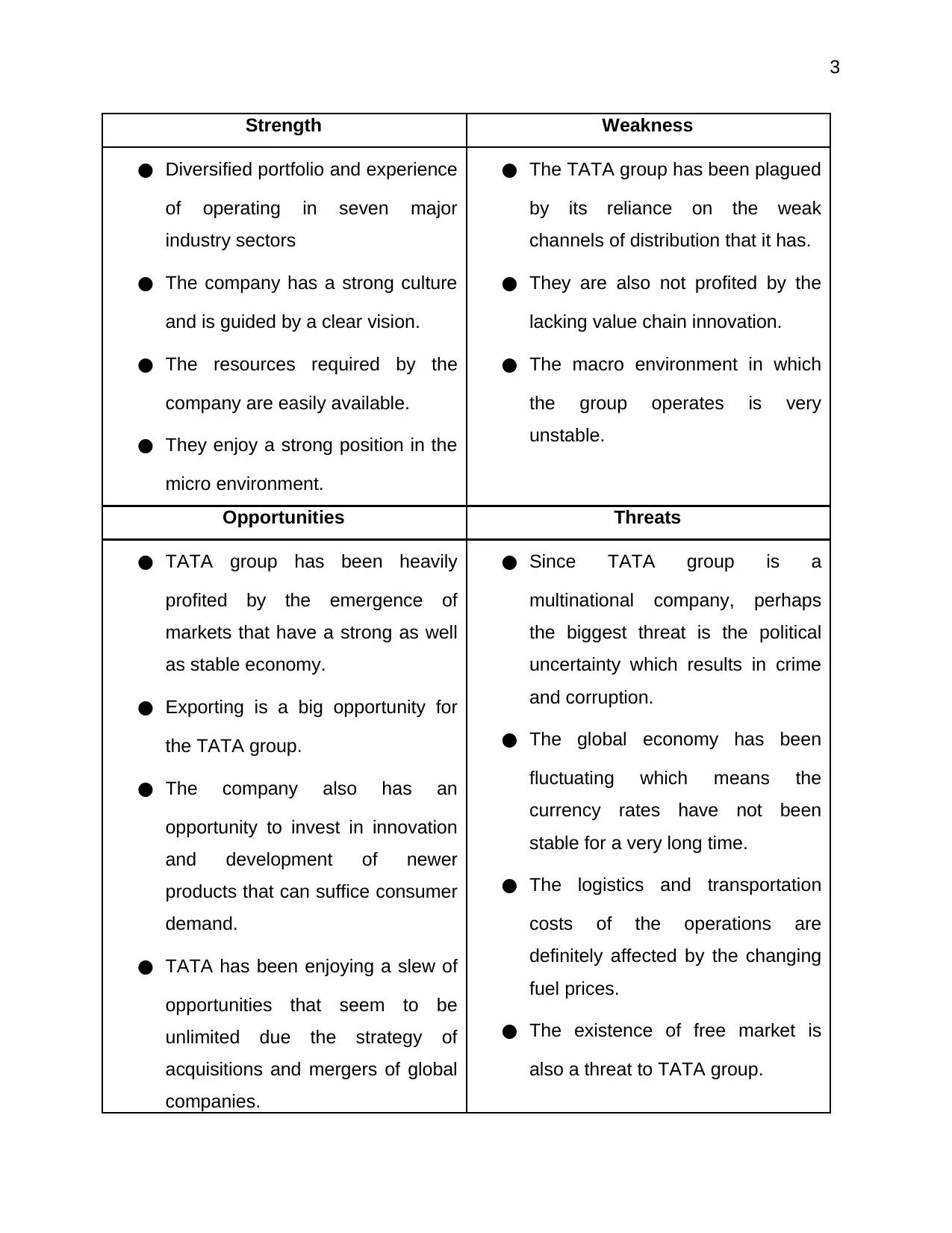
3
Strength Weakness
● Diversified portfolio and experience
of operating in seven major
industry sectors
● The company has a strong culture
and is guided by a clear vision.
● The resources required by the
company are easily available.
● They enjoy a strong position in the
micro environment.
● The TATA group has been plagued
by its reliance on the weak
channels of distribution that it has.
● They are also not profited by the
lacking value chain innovation.
● The macro environment in which
the group operates is very
unstable.
Opportunities Threats
● TATA group has been heavily
profited by the emergence of
markets that have a strong as well
as stable economy.
● Exporting is a big opportunity for
the TATA group.
● The company also has an
opportunity to invest in innovation
and development of newer
products that can suffice consumer
demand.
● TATA has been enjoying a slew of
opportunities that seem to be
unlimited due the strategy of
acquisitions and mergers of global
companies.
● Since TATA group is a
multinational company, perhaps
the biggest threat is the political
uncertainty which results in crime
and corruption.
● The global economy has been
fluctuating which means the
currency rates have not been
stable for a very long time.
● The logistics and transportation
costs of the operations are
definitely affected by the changing
fuel prices.
● The existence of free market is
also a threat to TATA group.
Strength Weakness
● Diversified portfolio and experience
of operating in seven major
industry sectors
● The company has a strong culture
and is guided by a clear vision.
● The resources required by the
company are easily available.
● They enjoy a strong position in the
micro environment.
● The TATA group has been plagued
by its reliance on the weak
channels of distribution that it has.
● They are also not profited by the
lacking value chain innovation.
● The macro environment in which
the group operates is very
unstable.
Opportunities Threats
● TATA group has been heavily
profited by the emergence of
markets that have a strong as well
as stable economy.
● Exporting is a big opportunity for
the TATA group.
● The company also has an
opportunity to invest in innovation
and development of newer
products that can suffice consumer
demand.
● TATA has been enjoying a slew of
opportunities that seem to be
unlimited due the strategy of
acquisitions and mergers of global
companies.
● Since TATA group is a
multinational company, perhaps
the biggest threat is the political
uncertainty which results in crime
and corruption.
● The global economy has been
fluctuating which means the
currency rates have not been
stable for a very long time.
● The logistics and transportation
costs of the operations are
definitely affected by the changing
fuel prices.
● The existence of free market is
also a threat to TATA group.
Paraphrase This Document
Need a fresh take? Get an instant paraphrase of this document with our AI Paraphraser
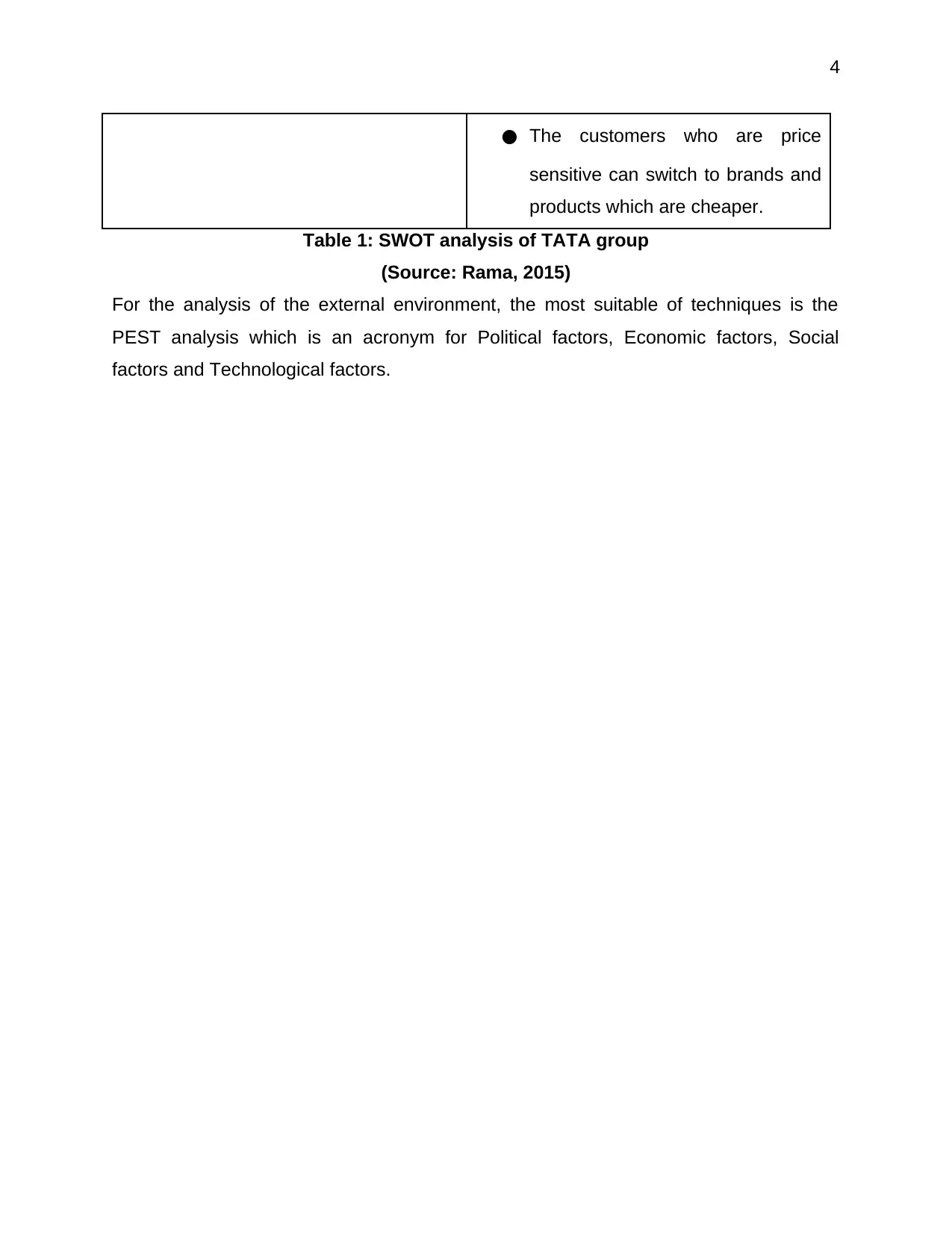
4
● The customers who are price
sensitive can switch to brands and
products which are cheaper.
Table 1: SWOT analysis of TATA group
(Source: Rama, 2015)
For the analysis of the external environment, the most suitable of techniques is the
PEST analysis which is an acronym for Political factors, Economic factors, Social
factors and Technological factors.
● The customers who are price
sensitive can switch to brands and
products which are cheaper.
Table 1: SWOT analysis of TATA group
(Source: Rama, 2015)
For the analysis of the external environment, the most suitable of techniques is the
PEST analysis which is an acronym for Political factors, Economic factors, Social
factors and Technological factors.
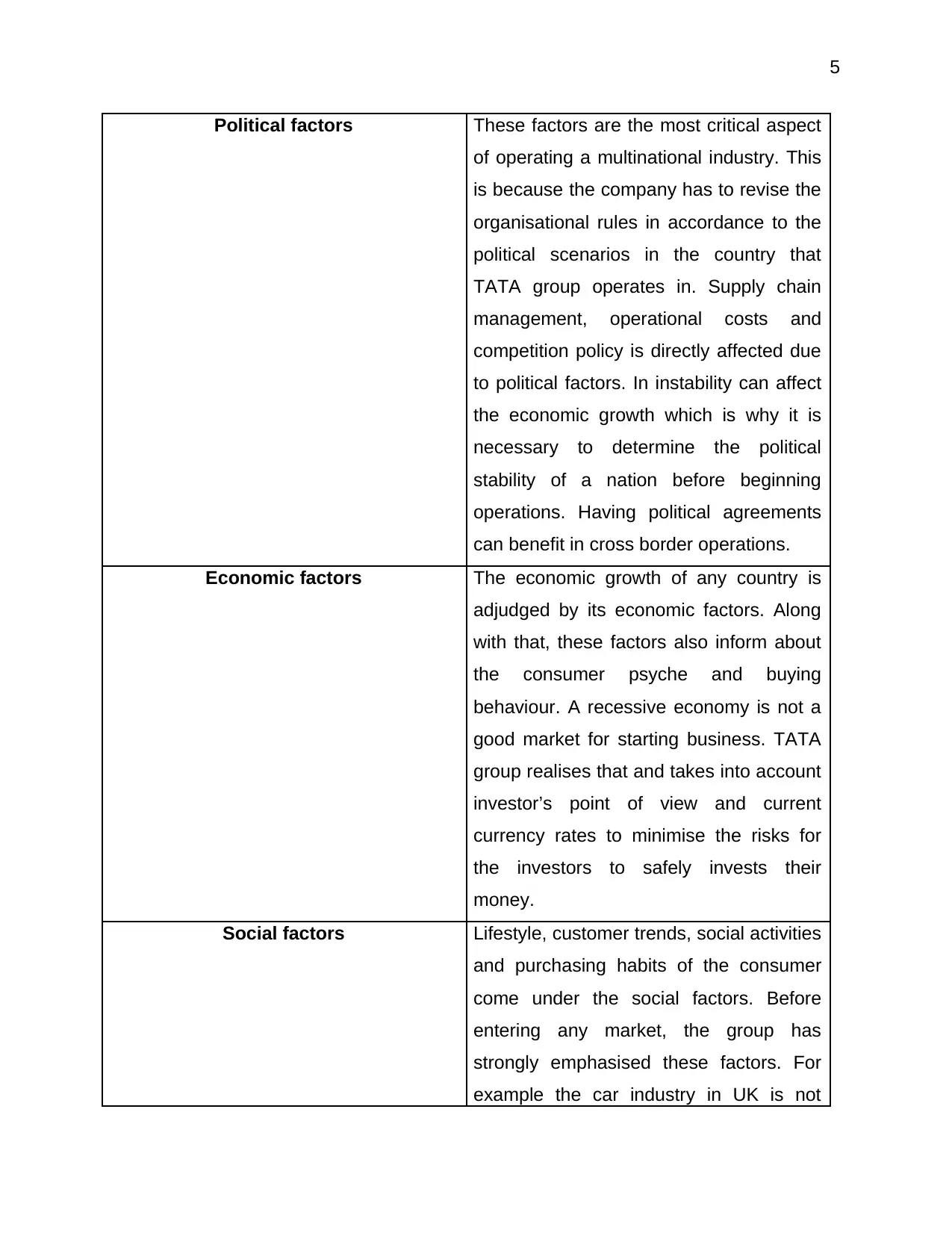
5
Political factors These factors are the most critical aspect
of operating a multinational industry. This
is because the company has to revise the
organisational rules in accordance to the
political scenarios in the country that
TATA group operates in. Supply chain
management, operational costs and
competition policy is directly affected due
to political factors. In instability can affect
the economic growth which is why it is
necessary to determine the political
stability of a nation before beginning
operations. Having political agreements
can benefit in cross border operations.
Economic factors The economic growth of any country is
adjudged by its economic factors. Along
with that, these factors also inform about
the consumer psyche and buying
behaviour. A recessive economy is not a
good market for starting business. TATA
group realises that and takes into account
investor’s point of view and current
currency rates to minimise the risks for
the investors to safely invests their
money.
Social factors Lifestyle, customer trends, social activities
and purchasing habits of the consumer
come under the social factors. Before
entering any market, the group has
strongly emphasised these factors. For
example the car industry in UK is not
Political factors These factors are the most critical aspect
of operating a multinational industry. This
is because the company has to revise the
organisational rules in accordance to the
political scenarios in the country that
TATA group operates in. Supply chain
management, operational costs and
competition policy is directly affected due
to political factors. In instability can affect
the economic growth which is why it is
necessary to determine the political
stability of a nation before beginning
operations. Having political agreements
can benefit in cross border operations.
Economic factors The economic growth of any country is
adjudged by its economic factors. Along
with that, these factors also inform about
the consumer psyche and buying
behaviour. A recessive economy is not a
good market for starting business. TATA
group realises that and takes into account
investor’s point of view and current
currency rates to minimise the risks for
the investors to safely invests their
money.
Social factors Lifestyle, customer trends, social activities
and purchasing habits of the consumer
come under the social factors. Before
entering any market, the group has
strongly emphasised these factors. For
example the car industry in UK is not
⊘ This is a preview!⊘
Do you want full access?
Subscribe today to unlock all pages.

Trusted by 1+ million students worldwide
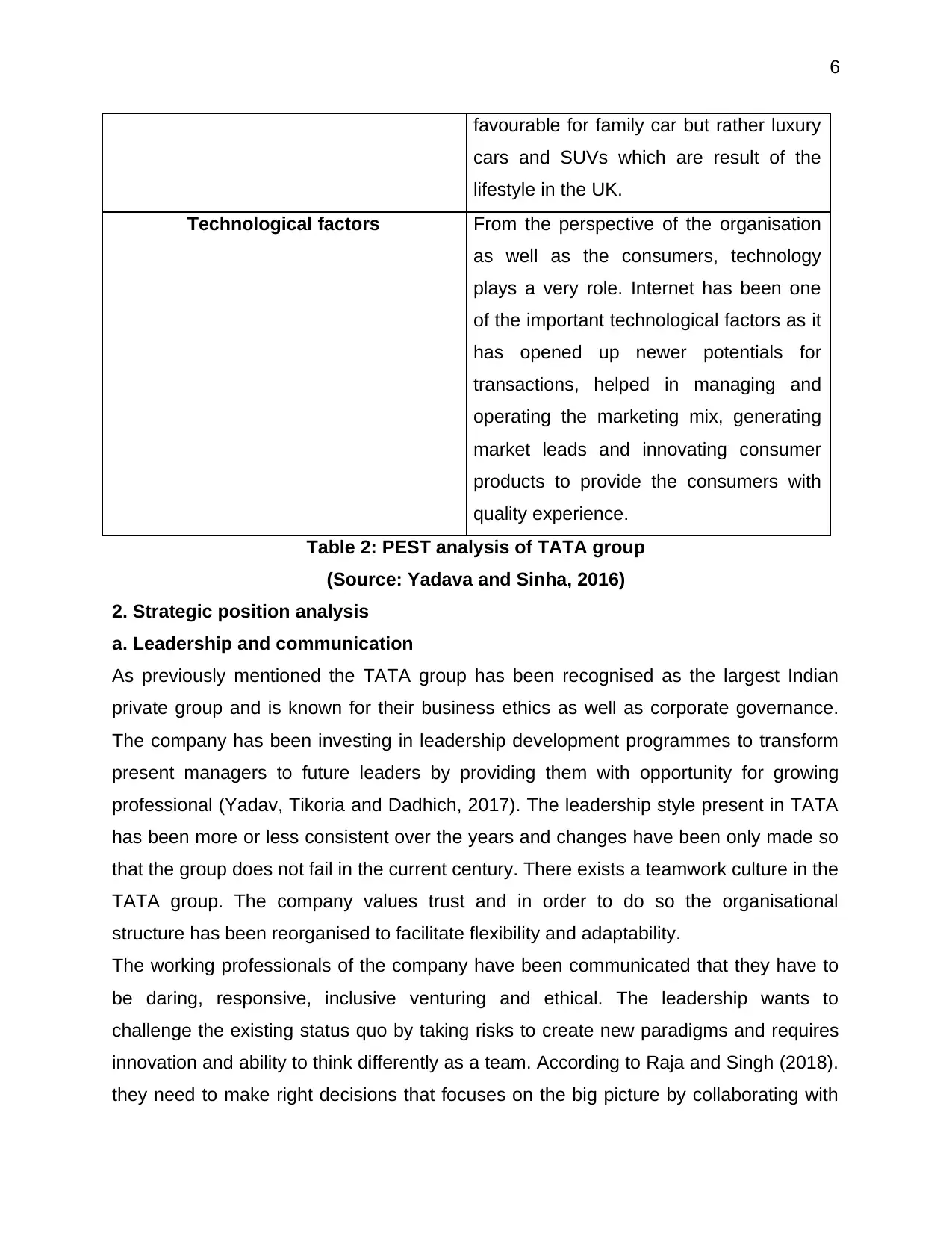
6
favourable for family car but rather luxury
cars and SUVs which are result of the
lifestyle in the UK.
Technological factors From the perspective of the organisation
as well as the consumers, technology
plays a very role. Internet has been one
of the important technological factors as it
has opened up newer potentials for
transactions, helped in managing and
operating the marketing mix, generating
market leads and innovating consumer
products to provide the consumers with
quality experience.
Table 2: PEST analysis of TATA group
(Source: Yadava and Sinha, 2016)
2. Strategic position analysis
a. Leadership and communication
As previously mentioned the TATA group has been recognised as the largest Indian
private group and is known for their business ethics as well as corporate governance.
The company has been investing in leadership development programmes to transform
present managers to future leaders by providing them with opportunity for growing
professional (Yadav, Tikoria and Dadhich, 2017). The leadership style present in TATA
has been more or less consistent over the years and changes have been only made so
that the group does not fail in the current century. There exists a teamwork culture in the
TATA group. The company values trust and in order to do so the organisational
structure has been reorganised to facilitate flexibility and adaptability.
The working professionals of the company have been communicated that they have to
be daring, responsive, inclusive venturing and ethical. The leadership wants to
challenge the existing status quo by taking risks to create new paradigms and requires
innovation and ability to think differently as a team. According to Raja and Singh (2018).
they need to make right decisions that focuses on the big picture by collaborating with
favourable for family car but rather luxury
cars and SUVs which are result of the
lifestyle in the UK.
Technological factors From the perspective of the organisation
as well as the consumers, technology
plays a very role. Internet has been one
of the important technological factors as it
has opened up newer potentials for
transactions, helped in managing and
operating the marketing mix, generating
market leads and innovating consumer
products to provide the consumers with
quality experience.
Table 2: PEST analysis of TATA group
(Source: Yadava and Sinha, 2016)
2. Strategic position analysis
a. Leadership and communication
As previously mentioned the TATA group has been recognised as the largest Indian
private group and is known for their business ethics as well as corporate governance.
The company has been investing in leadership development programmes to transform
present managers to future leaders by providing them with opportunity for growing
professional (Yadav, Tikoria and Dadhich, 2017). The leadership style present in TATA
has been more or less consistent over the years and changes have been only made so
that the group does not fail in the current century. There exists a teamwork culture in the
TATA group. The company values trust and in order to do so the organisational
structure has been reorganised to facilitate flexibility and adaptability.
The working professionals of the company have been communicated that they have to
be daring, responsive, inclusive venturing and ethical. The leadership wants to
challenge the existing status quo by taking risks to create new paradigms and requires
innovation and ability to think differently as a team. According to Raja and Singh (2018).
they need to make right decisions that focuses on the big picture by collaborating with
Paraphrase This Document
Need a fresh take? Get an instant paraphrase of this document with our AI Paraphraser
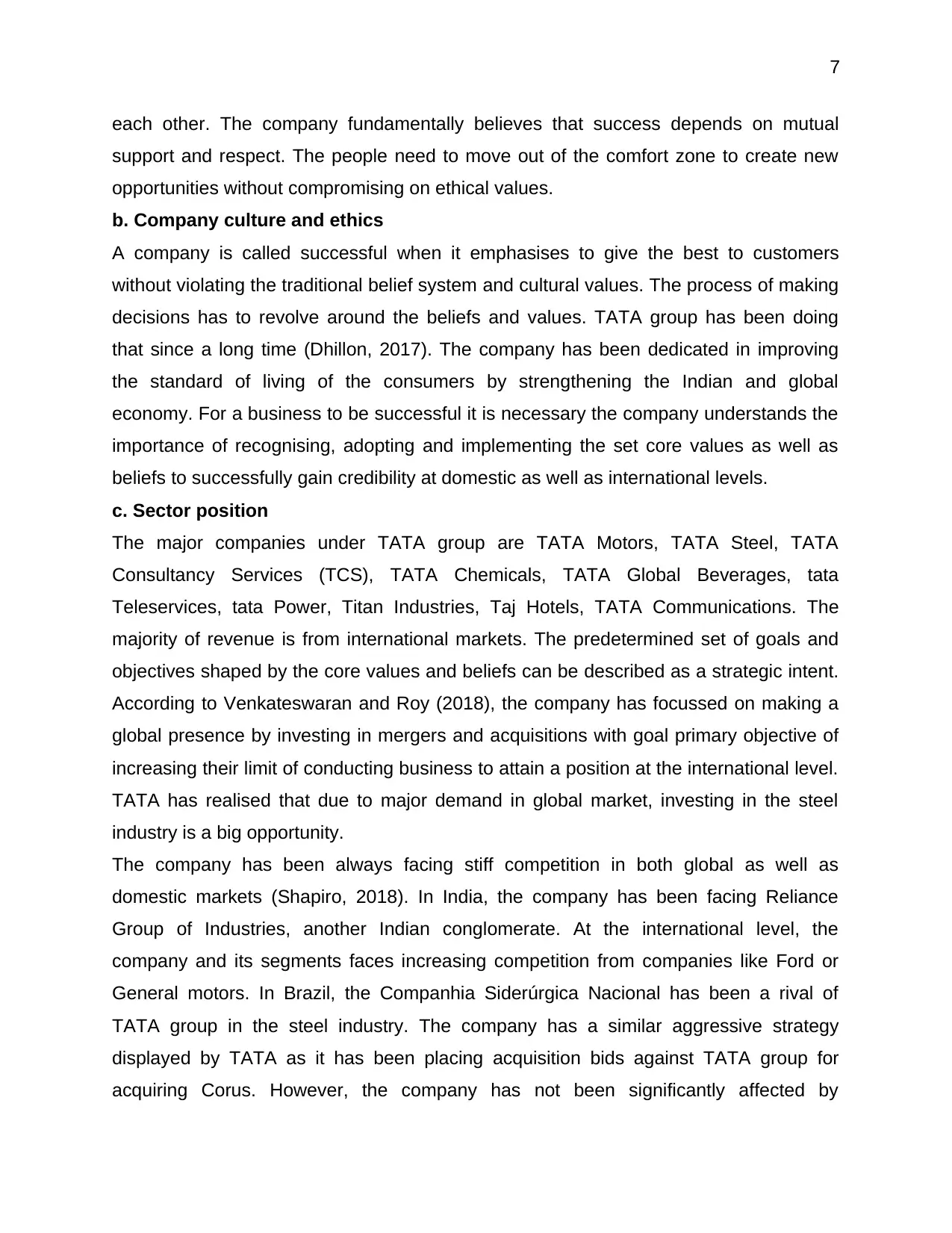
7
each other. The company fundamentally believes that success depends on mutual
support and respect. The people need to move out of the comfort zone to create new
opportunities without compromising on ethical values.
b. Company culture and ethics
A company is called successful when it emphasises to give the best to customers
without violating the traditional belief system and cultural values. The process of making
decisions has to revolve around the beliefs and values. TATA group has been doing
that since a long time (Dhillon, 2017). The company has been dedicated in improving
the standard of living of the consumers by strengthening the Indian and global
economy. For a business to be successful it is necessary the company understands the
importance of recognising, adopting and implementing the set core values as well as
beliefs to successfully gain credibility at domestic as well as international levels.
c. Sector position
The major companies under TATA group are TATA Motors, TATA Steel, TATA
Consultancy Services (TCS), TATA Chemicals, TATA Global Beverages, tata
Teleservices, tata Power, Titan Industries, Taj Hotels, TATA Communications. The
majority of revenue is from international markets. The predetermined set of goals and
objectives shaped by the core values and beliefs can be described as a strategic intent.
According to Venkateswaran and Roy (2018), the company has focussed on making a
global presence by investing in mergers and acquisitions with goal primary objective of
increasing their limit of conducting business to attain a position at the international level.
TATA has realised that due to major demand in global market, investing in the steel
industry is a big opportunity.
The company has been always facing stiff competition in both global as well as
domestic markets (Shapiro, 2018). In India, the company has been facing Reliance
Group of Industries, another Indian conglomerate. At the international level, the
company and its segments faces increasing competition from companies like Ford or
General motors. In Brazil, the Companhia Siderúrgica Nacional has been a rival of
TATA group in the steel industry. The company has a similar aggressive strategy
displayed by TATA as it has been placing acquisition bids against TATA group for
acquiring Corus. However, the company has not been significantly affected by
each other. The company fundamentally believes that success depends on mutual
support and respect. The people need to move out of the comfort zone to create new
opportunities without compromising on ethical values.
b. Company culture and ethics
A company is called successful when it emphasises to give the best to customers
without violating the traditional belief system and cultural values. The process of making
decisions has to revolve around the beliefs and values. TATA group has been doing
that since a long time (Dhillon, 2017). The company has been dedicated in improving
the standard of living of the consumers by strengthening the Indian and global
economy. For a business to be successful it is necessary the company understands the
importance of recognising, adopting and implementing the set core values as well as
beliefs to successfully gain credibility at domestic as well as international levels.
c. Sector position
The major companies under TATA group are TATA Motors, TATA Steel, TATA
Consultancy Services (TCS), TATA Chemicals, TATA Global Beverages, tata
Teleservices, tata Power, Titan Industries, Taj Hotels, TATA Communications. The
majority of revenue is from international markets. The predetermined set of goals and
objectives shaped by the core values and beliefs can be described as a strategic intent.
According to Venkateswaran and Roy (2018), the company has focussed on making a
global presence by investing in mergers and acquisitions with goal primary objective of
increasing their limit of conducting business to attain a position at the international level.
TATA has realised that due to major demand in global market, investing in the steel
industry is a big opportunity.
The company has been always facing stiff competition in both global as well as
domestic markets (Shapiro, 2018). In India, the company has been facing Reliance
Group of Industries, another Indian conglomerate. At the international level, the
company and its segments faces increasing competition from companies like Ford or
General motors. In Brazil, the Companhia Siderúrgica Nacional has been a rival of
TATA group in the steel industry. The company has a similar aggressive strategy
displayed by TATA as it has been placing acquisition bids against TATA group for
acquiring Corus. However, the company has not been significantly affected by
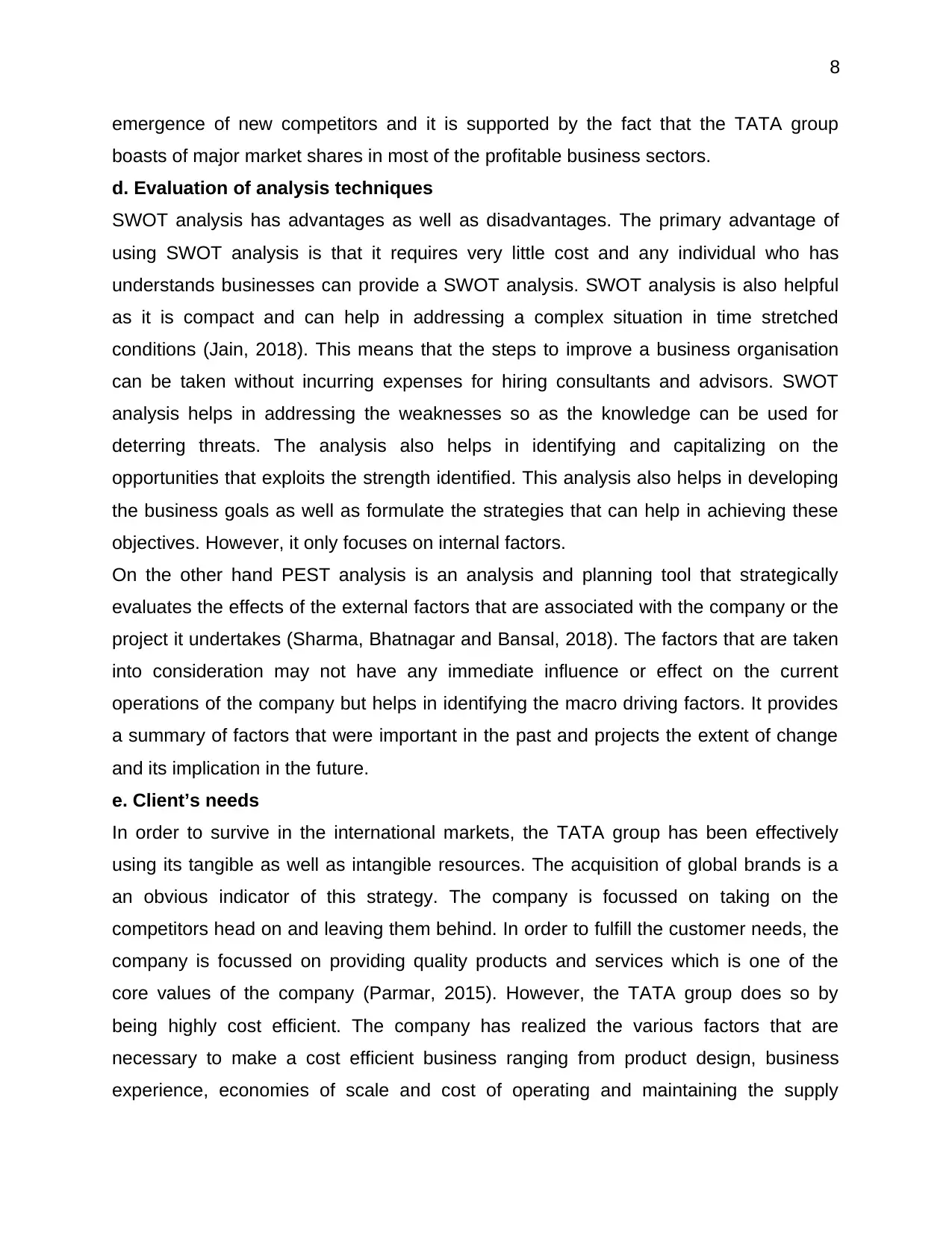
8
emergence of new competitors and it is supported by the fact that the TATA group
boasts of major market shares in most of the profitable business sectors.
d. Evaluation of analysis techniques
SWOT analysis has advantages as well as disadvantages. The primary advantage of
using SWOT analysis is that it requires very little cost and any individual who has
understands businesses can provide a SWOT analysis. SWOT analysis is also helpful
as it is compact and can help in addressing a complex situation in time stretched
conditions (Jain, 2018). This means that the steps to improve a business organisation
can be taken without incurring expenses for hiring consultants and advisors. SWOT
analysis helps in addressing the weaknesses so as the knowledge can be used for
deterring threats. The analysis also helps in identifying and capitalizing on the
opportunities that exploits the strength identified. This analysis also helps in developing
the business goals as well as formulate the strategies that can help in achieving these
objectives. However, it only focuses on internal factors.
On the other hand PEST analysis is an analysis and planning tool that strategically
evaluates the effects of the external factors that are associated with the company or the
project it undertakes (Sharma, Bhatnagar and Bansal, 2018). The factors that are taken
into consideration may not have any immediate influence or effect on the current
operations of the company but helps in identifying the macro driving factors. It provides
a summary of factors that were important in the past and projects the extent of change
and its implication in the future.
e. Client’s needs
In order to survive in the international markets, the TATA group has been effectively
using its tangible as well as intangible resources. The acquisition of global brands is a
an obvious indicator of this strategy. The company is focussed on taking on the
competitors head on and leaving them behind. In order to fulfill the customer needs, the
company is focussed on providing quality products and services which is one of the
core values of the company (Parmar, 2015). However, the TATA group does so by
being highly cost efficient. The company has realized the various factors that are
necessary to make a cost efficient business ranging from product design, business
experience, economies of scale and cost of operating and maintaining the supply
emergence of new competitors and it is supported by the fact that the TATA group
boasts of major market shares in most of the profitable business sectors.
d. Evaluation of analysis techniques
SWOT analysis has advantages as well as disadvantages. The primary advantage of
using SWOT analysis is that it requires very little cost and any individual who has
understands businesses can provide a SWOT analysis. SWOT analysis is also helpful
as it is compact and can help in addressing a complex situation in time stretched
conditions (Jain, 2018). This means that the steps to improve a business organisation
can be taken without incurring expenses for hiring consultants and advisors. SWOT
analysis helps in addressing the weaknesses so as the knowledge can be used for
deterring threats. The analysis also helps in identifying and capitalizing on the
opportunities that exploits the strength identified. This analysis also helps in developing
the business goals as well as formulate the strategies that can help in achieving these
objectives. However, it only focuses on internal factors.
On the other hand PEST analysis is an analysis and planning tool that strategically
evaluates the effects of the external factors that are associated with the company or the
project it undertakes (Sharma, Bhatnagar and Bansal, 2018). The factors that are taken
into consideration may not have any immediate influence or effect on the current
operations of the company but helps in identifying the macro driving factors. It provides
a summary of factors that were important in the past and projects the extent of change
and its implication in the future.
e. Client’s needs
In order to survive in the international markets, the TATA group has been effectively
using its tangible as well as intangible resources. The acquisition of global brands is a
an obvious indicator of this strategy. The company is focussed on taking on the
competitors head on and leaving them behind. In order to fulfill the customer needs, the
company is focussed on providing quality products and services which is one of the
core values of the company (Parmar, 2015). However, the TATA group does so by
being highly cost efficient. The company has realized the various factors that are
necessary to make a cost efficient business ranging from product design, business
experience, economies of scale and cost of operating and maintaining the supply
⊘ This is a preview!⊘
Do you want full access?
Subscribe today to unlock all pages.

Trusted by 1+ million students worldwide
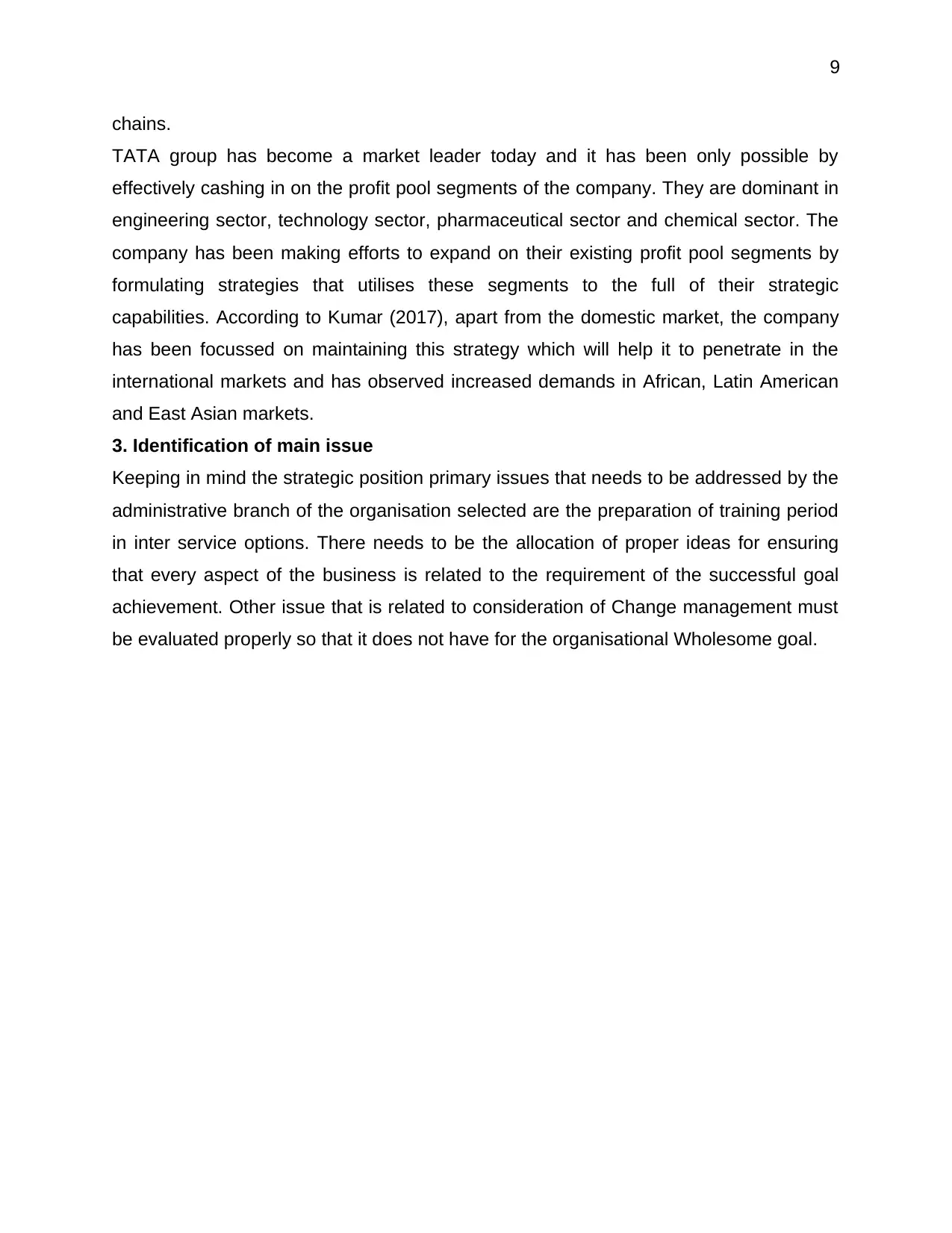
9
chains.
TATA group has become a market leader today and it has been only possible by
effectively cashing in on the profit pool segments of the company. They are dominant in
engineering sector, technology sector, pharmaceutical sector and chemical sector. The
company has been making efforts to expand on their existing profit pool segments by
formulating strategies that utilises these segments to the full of their strategic
capabilities. According to Kumar (2017), apart from the domestic market, the company
has been focussed on maintaining this strategy which will help it to penetrate in the
international markets and has observed increased demands in African, Latin American
and East Asian markets.
3. Identification of main issue
Keeping in mind the strategic position primary issues that needs to be addressed by the
administrative branch of the organisation selected are the preparation of training period
in inter service options. There needs to be the allocation of proper ideas for ensuring
that every aspect of the business is related to the requirement of the successful goal
achievement. Other issue that is related to consideration of Change management must
be evaluated properly so that it does not have for the organisational Wholesome goal.
chains.
TATA group has become a market leader today and it has been only possible by
effectively cashing in on the profit pool segments of the company. They are dominant in
engineering sector, technology sector, pharmaceutical sector and chemical sector. The
company has been making efforts to expand on their existing profit pool segments by
formulating strategies that utilises these segments to the full of their strategic
capabilities. According to Kumar (2017), apart from the domestic market, the company
has been focussed on maintaining this strategy which will help it to penetrate in the
international markets and has observed increased demands in African, Latin American
and East Asian markets.
3. Identification of main issue
Keeping in mind the strategic position primary issues that needs to be addressed by the
administrative branch of the organisation selected are the preparation of training period
in inter service options. There needs to be the allocation of proper ideas for ensuring
that every aspect of the business is related to the requirement of the successful goal
achievement. Other issue that is related to consideration of Change management must
be evaluated properly so that it does not have for the organisational Wholesome goal.
Paraphrase This Document
Need a fresh take? Get an instant paraphrase of this document with our AI Paraphraser
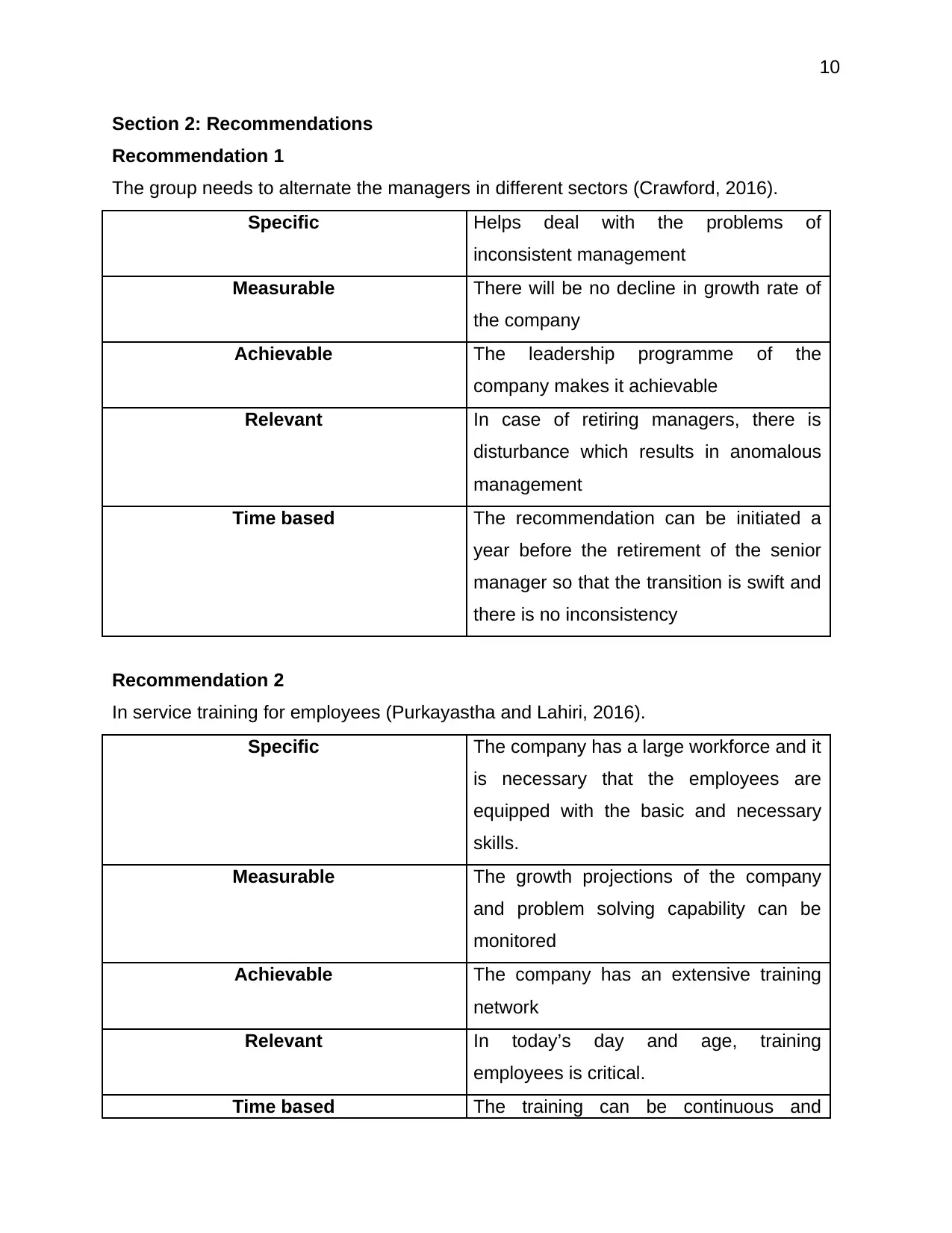
10
Section 2: Recommendations
Recommendation 1
The group needs to alternate the managers in different sectors (Crawford, 2016).
Specific Helps deal with the problems of
inconsistent management
Measurable There will be no decline in growth rate of
the company
Achievable The leadership programme of the
company makes it achievable
Relevant In case of retiring managers, there is
disturbance which results in anomalous
management
Time based The recommendation can be initiated a
year before the retirement of the senior
manager so that the transition is swift and
there is no inconsistency
Recommendation 2
In service training for employees (Purkayastha and Lahiri, 2016).
Specific The company has a large workforce and it
is necessary that the employees are
equipped with the basic and necessary
skills.
Measurable The growth projections of the company
and problem solving capability can be
monitored
Achievable The company has an extensive training
network
Relevant In today’s day and age, training
employees is critical.
Time based The training can be continuous and
Section 2: Recommendations
Recommendation 1
The group needs to alternate the managers in different sectors (Crawford, 2016).
Specific Helps deal with the problems of
inconsistent management
Measurable There will be no decline in growth rate of
the company
Achievable The leadership programme of the
company makes it achievable
Relevant In case of retiring managers, there is
disturbance which results in anomalous
management
Time based The recommendation can be initiated a
year before the retirement of the senior
manager so that the transition is swift and
there is no inconsistency
Recommendation 2
In service training for employees (Purkayastha and Lahiri, 2016).
Specific The company has a large workforce and it
is necessary that the employees are
equipped with the basic and necessary
skills.
Measurable The growth projections of the company
and problem solving capability can be
monitored
Achievable The company has an extensive training
network
Relevant In today’s day and age, training
employees is critical.
Time based The training can be continuous and
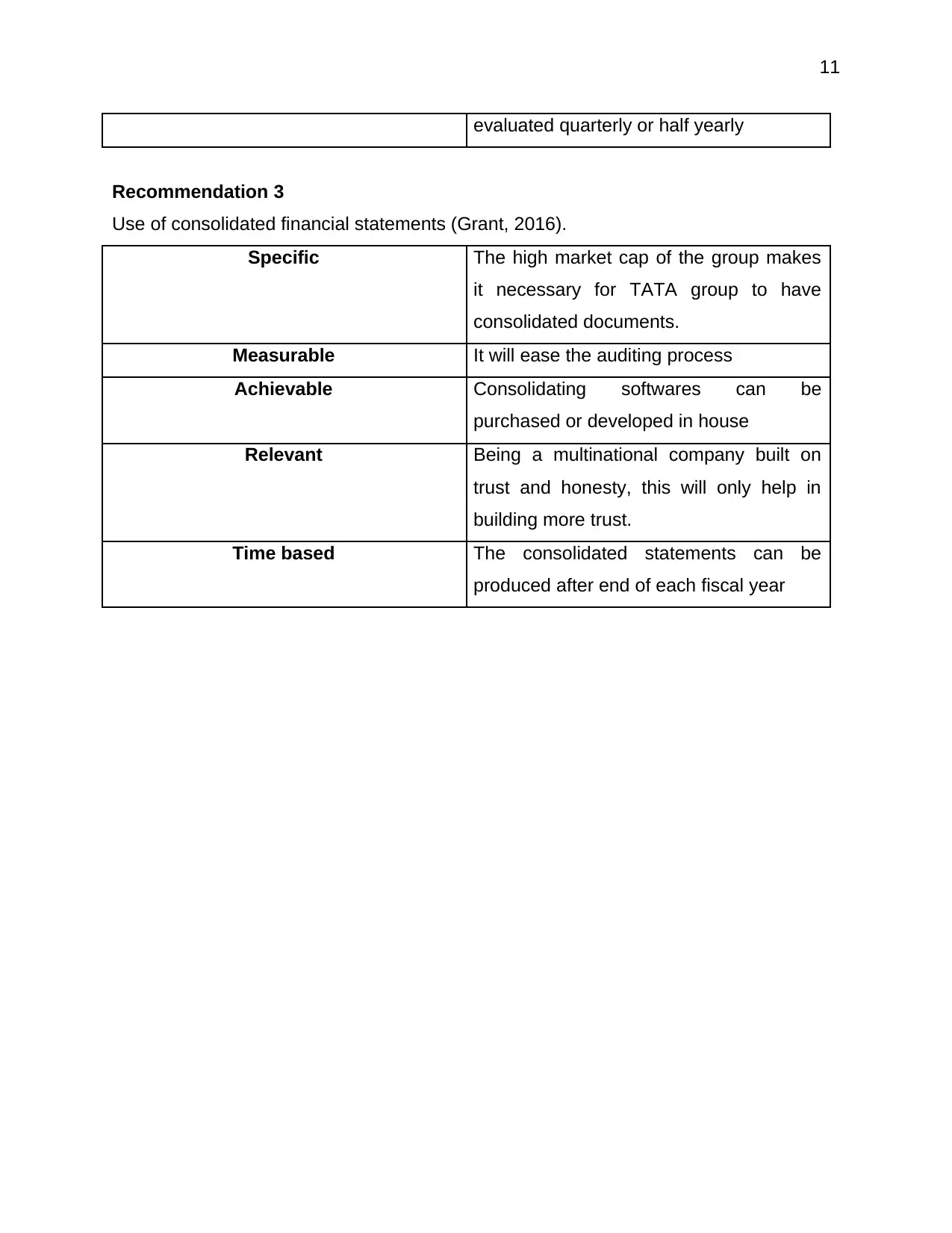
11
evaluated quarterly or half yearly
Recommendation 3
Use of consolidated financial statements (Grant, 2016).
Specific The high market cap of the group makes
it necessary for TATA group to have
consolidated documents.
Measurable It will ease the auditing process
Achievable Consolidating softwares can be
purchased or developed in house
Relevant Being a multinational company built on
trust and honesty, this will only help in
building more trust.
Time based The consolidated statements can be
produced after end of each fiscal year
evaluated quarterly or half yearly
Recommendation 3
Use of consolidated financial statements (Grant, 2016).
Specific The high market cap of the group makes
it necessary for TATA group to have
consolidated documents.
Measurable It will ease the auditing process
Achievable Consolidating softwares can be
purchased or developed in house
Relevant Being a multinational company built on
trust and honesty, this will only help in
building more trust.
Time based The consolidated statements can be
produced after end of each fiscal year
⊘ This is a preview!⊘
Do you want full access?
Subscribe today to unlock all pages.

Trusted by 1+ million students worldwide
1 out of 18
Related Documents
Your All-in-One AI-Powered Toolkit for Academic Success.
+13062052269
info@desklib.com
Available 24*7 on WhatsApp / Email
![[object Object]](/_next/static/media/star-bottom.7253800d.svg)
Unlock your academic potential
Copyright © 2020–2025 A2Z Services. All Rights Reserved. Developed and managed by ZUCOL.





